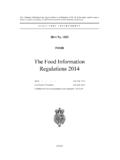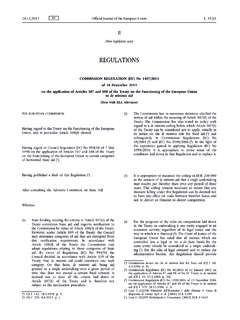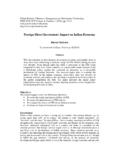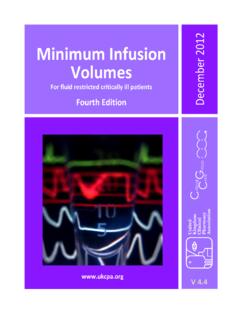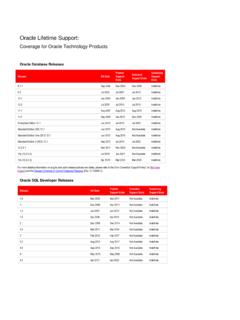Transcription of What Is the Farm Bill? - Federation of American Scientists
1 What Is the farm bill ? Updated September 26, 2019. Congressional Research Service RS22131. What Is the farm bill ? Summary The farm bill is an omnibus, multiyear law that governs an array of agricultural and food programs. Titles in the most recent farm bill encompassed farm commodity revenue supports, agricultural conservation, trade and foreign food assistance, farm credit, research, rural development, forestry, bioenergy, horticulture, and domestic nutrition assistance. Typically renewed about every five or six years, the farm bill provides a predictable opportunity for policymakers to comprehensively and periodically address agricultural and food issues. The most recent farm bill the Agriculture Improvement Act of 2018, 115-334 was enacted into law in december 2018 and expires in 2023. It succeeded the Agricultural Act of 2014 ( 113-79).
2 Provisions in the 2018 farm bill modified the structure of farm commodity support, expanded crop insurance coverage, amended conservation programs, reauthorized and revised nutrition assistance, and extended authority to appropriate funds for many Department of Agriculture (USDA) discretionary programs through FY2023. At enactment in december 2018, the Congressional Budget Office (CBO) estimated that the total cost of the mandatory programs in the farm bill would be $428 billion over its five-year duration, FY2019-FY2023, about $ billion more than if the 2014 farm bill were extended. On a 10-year basis, the expected cost was $867 billion over FY2019-FY2028, which was budget neutral compared to extending the 2014 farm bill . Four titles account for 99% of anticipated farm bill mandatory outlays: Nutrition, Crop Insurance, farm Commodity Support, and Conservation.
3 The Nutrition title comprises 76% of mandatory outlays, mostly for the Supplemental Nutrition Assistance Program (SNAP). The remaining 24%. of outlays covers mostly risk management and commodity support (16%) and conservation (7%). Programs in all other farm bill titles account for about 1% of mandatory outlays. Many programs are authorized to receive discretionary (appropriated) funds. The distribution of spending across titles in the farm bill over time is not a zero-sum game. Legislative changes enacted in each farm bill account for only a fraction of the observed change between farm bills. Every year, CBO re-estimates the baseline to determine expected costs. Baseline projections can rise and fall over time based on changes in economic conditions, even without any action by Congress. For example, SNAP outlays, which comprise most of the Nutrition title, increased markedly through the recession that ended in 2009.
4 Crop insurance outlays have increased steadily from policy changes, while the farm commodity programs have risen and fallen counter-cyclically with market prices. Conservation program outlays increased steadily since the 1990s but have leveled off in recent years. Congressional Research Service What Is the farm bill ? Contents What Is the farm bill ? .. 1. What Is the Estimated Cost of the farm bill ? .. 4. How Much Was It Expected to Cost at Enactment in 2018?.. 4. How Have Projections Changed Since Enactment? .. 4. How Have the Allocations Changed over Time? .. 6. Title-by-Title Summaries of the 2018 farm bill .. 8. Title I: Commodities .. 8. Title II: Conservation .. 8. Title III: Trade .. 9. Title IV: 9. Title V: Credit .. 10. Title VI: Rural Development .. 10. Title VII: Research, Extension, and Related Matters.
5 11. Title VIII: Forestry .. 11. Title X: Energy .. 11. Title X: Horticulture .. 12. Title XI: Crop 12. Title XII: 13. Figures Figure 1. Selected Dates for farm bill Policy and Selected Related 3. Figure 2. Projected Outlays of the 2018 farm bill at Enactment .. 5. Figure 3. Actual and Projected Spending by Major farm bill Mandatory Programs .. 7. Tables Table 1. Budget for the 2018 farm bill .. 5. Table 2. Projected Outlays of the 2018 farm bill Since Enactment .. 6. Table 3. Distribution of farm bill Titles in 2008, 2014 , and 7. Contacts Author 13. Congressional Research Service What Is the farm bill ? What Is the farm bill ? The farm bill is an omnibus, multiyear law that governs an array of agricultural and food programs. Although agricultural policies are sometimes created and changed by freestanding legislation or as part of other major laws, the farm bill provides a predictable opportunity for policymakers to comprehensively and periodically address agricultural and food issues.
6 The farm bill is typically renewed about every five or six Historically, farm bills focused on farm commodity program support for a handful of staple commodities corn, soybeans, wheat, cotton, rice, peanuts, dairy, and sugar. farm bills have become increasingly expansive in nature since 1973, when a nutrition title was first included. Other prominent additions since then include conservation, horticulture, and The omnibus nature of the farm bill can create broad coalitions of support among sometimes conflicting interests for policies that, individually, might have greater difficulty negotiating the legislative process. This can lead to competition for funds provided in a farm bill . In recent years, more stakeholders have become involved in the debate on farm bills, including national farm groups; commodity associations; state organizations; nutrition and public health officials; and advocacy groups representing conservation, recreation, rural development, faith-based interests, local food systems, and certified organic production.
7 The Agriculture Improvement Act of 2018 ( 115-334, 115-1072), referred to here as the 2018 farm bill , is the most recent omnibus farm bill . It was enacted in december 2018, with most provisions expiring in 2023. It succeeded the Agricultural Act of 2014 ( 113-79; 2014 . farm bill ). The 2018 farm bill contains 12 titles encompassing commodity revenue supports, farm credit, trade, agricultural conservation, research, rural development, energy, and foreign and domestic food programs, among other (All titles in the 2018 farm bill are described in the text box below as well as in the section Title-by-Title Summaries of the 2018 farm bill . ). Provisions in the 2018 farm bill modified the structure of farm commodity support, expanded crop insurance coverage, amended conservation programs, reauthorized and revised nutrition assistance, and extended authority to appropriate funds for many Department of Agriculture (USDA) discretionary programs through FY2023.
8 Without reauthorization, some farm bill programs would expire, such as the nutrition assistance programs and the farm commodity revenue programs. Procedurally, the potential for expiration and the consequences of expired law may motivate legislative Functionally, without reauthorization, support for certain basic farm commodities would revert to long-abandoned . and potentially costly supply-control and price regimes under permanent law dating back to the 1940s. Some programs would cease to operate unless reauthorized, while others might continue to pay only existing obligations. Nutrition assistance programs that require reauthorization and 1 See CRS Report R45210, farm Bills: Major Legislative Actions, 1965-2018. Since the 1930s, there have been 18. farm bills (2018, 2014 , 2008, 2002, 1996, 1990, 1985, 1981, 1977, 1973, 1970, 1965, 1956, 1954, 1949, 1948, 1938, and 1933).
9 2 See also CRS In Focus IF11126, 2018 farm bill Primer: What Is the farm bill ? 3 See CRS Report R45525, The 2018 farm bill ( 115-334): Summary and Side-by-Side Comparison. 4 For example, in 2012 Congress did not complete a new farm bill to replace the 2008 law, requiring a one-year extension for both FY2013 and crop year 2013. In 2013, Congress passed bills that culminated in the 2014 farm bill . Some programs, though, ceased to operate during the 2013 extension because they had no funding. For background, see CRS Report R41433, Programs Without a Budget Baseline at the End of the 2008 farm bill . Congressional Research Service 1. What Is the farm bill ? are funded with mandatory spending can continue to operate via appropriations acts. Many discretionary programs would lose their statutory authority to receive appropriations, though an annual appropriations act could provide funding under an implicit authorization.
10 Other programs amended in the farm bill have permanent authority ( , crop insurance).5. The 2018 farm bill : Functions and Major Issues, by Title Title I, Commodities: Provides farm payments when crop prices or revenues decline for major commodity crops, including wheat, corn, soybeans, peanuts, and rice. Includes disaster programs to help livestock and tree fruit producers manage production losses due to natural disasters. Other support includes margin coverage program for dairy and marketing quotas, minimum price guarantees, and import barriers for sugar. Title II, Conservation: Provides assistance to agricultural producers in addressing environmental resource concerns on private land through land retirement, conservation easements, working lands assistance, and partnership opportunities. Title III, Trade: Supports agricultural export programs and international food assistance programs.










